Learn Chess: The Only Guide You’ll Need
Learning chess can be intimidating at first, but let me tell you; it is well worth it. Chess is an incredibly challenging yet fun game, which can be played almost anywhere. Reason enough to learn all about chess, right?
Here’s an offer for you: Spend 10 minutes of your valuable time reading this guide, and you’ll be at a point where you can play a proper match of chess – deal?
Since you read on, I’ll just take that as a “Yes”. But before we start you need to promise me two things:
- You actually take the time to properly and thoroughly read this guide. No distractions, no skipping through.
- You will play your first game of chess right after you are done. We want you to enjoy the beautiful game of chess!
Ready? Let’s go 🙌!
Chess Basics: Understanding the Game
Before we get into the nitty gritty of chess theory, we need to get a basic understanding of the rules and goals of chess 📝.
Chess is a strategic board game played between two players – one controlling the white/light pieces, the other controlling the black/dark pieces. Chess is played on a square board with 64 squares in total. Both players take turns moving their pieces. The main objective of chess is to checkmate the opponent’s king, a concept we’ll take a closer look at later in this guide.
Learning Chess: Board Setup
Before the game can start the pieces need to be set into place on the chess board. Each game of chess starts with the same setup, also known as the starting position:
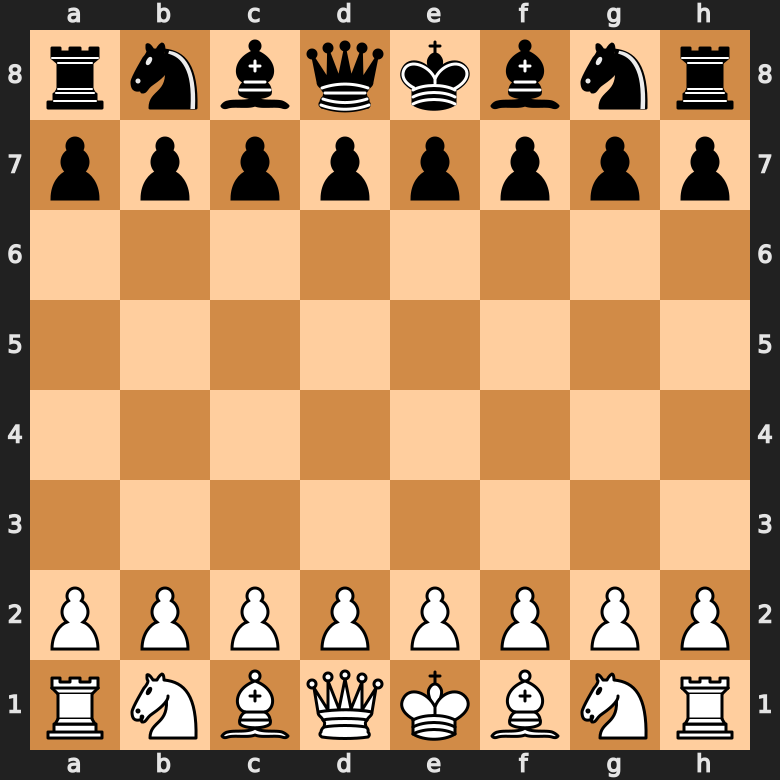
Feel free to set up a chess board next to you as you follow this chess guide. It’ll make learning chess a lot easier, as you can practice at the same time.
Learning the Chess Pieces
Now that we have the board setup down, we need to take a closer look at the individual pieces. This does require you to memorize quite a bit 🧠, but don’t worry: It’ll become second nature after just a few games.
Each player starts the game with 16 pieces, meaning there are 32 pieces on the board. There are six different kinds of pieces, that are distributed among the players as follows:
This is how the pieces look in real life:

Let’s take a closer look at each of the pieces – how do they move and what makes them special?
♔ King
The king is the most important piece in chess. Protecting your king should be your #1 priority.
The king can move exactly one step in a horizontal, vertical, or diagonal direction. Meaning, he can reach every square that is directly next to him on a given turn. Not very nimble, but he does have one trick up his sleeve: castling. A special move that allows the king to get himself out of harm’s way. We’ll get to attacking and defending the king a bit later in this guide.
You can check out our exhaustive guide on the king here:
♔ More Information on the King ♔♕ Queen
With the relative immobility of the king, it is only fitting that the queen is the most powerful (i. e. manoeuvrable) piece on the chess board. She can move any desired amount of empty squares in any directional line, meaning horizontally, vertically or diagonally. With that, she combines to movement of Rook and Bishop – two pieces we’ll look at in a second ⏱️.
While she is the strongest chess piece, the queen doesn’t have any special moves we need to worry about. Just remember: With great power comes great responsibility! So use your queen wisely or risk losing it.
Check out our in-depth article about the queen here:
♕ More Information on the Queen ♕♖ Rook
The rook is considered a major piece alongside the queen. Luckily, the movement pattern of the rook is quite easy to understand. The rules state that the rook can move any number of vacant squares in a straight line, both vertically and horizontally. Meaning it can move up, down, left or right for as far as it wants, until it encounters another piece.
Obviously the inventors of chess had to spoil the party by equipping the rook with a special move it can perform together with the king: castling. Castling is used to protect the king and bring the rook into the game. More about that later in the guide.
You can learn more about the rook in our dedicated guide:
♖ More Information on the Rook ♖♗ Bishop
The bishop is considered a minor piece, as it can not deliver a checkmate on its own (with a king, obviously). But don’t be fooled: the bishop can be a deadly force when used properly. It is also a rather simple piece, having no special moves to keep in mind.
The bishop can move any number of unoccupied squares diagonally. In fact, it is the only chess piece that only moves diagonally. Thus each of your two bishops is always bound to either the light or dark squares, depending on where it started.
More information about the bishop can be found here:
♗ More Information on the Bishop ♗♘ Knight
Just like the bishop, the knight is also a minor piece. It has a very unique way of moving across the chess board: It always moves two squares in any direction vertically and one horizontally, or the other way around: two squares horizontally and one vertically. Sounds confusing 🤯? Well, it sounds more complicated than it actually is. Just remember that the the knight moves in an “L-shape” in any direction.
The knight is also special in that it is the only piece that can jump over other pieces – both your own and your opponents. For that reason the knight always attacks a single square and not the squares along its path.
For a visualization of how the knight moves, check out our guide here:
♘ More Information on the Knight ♘♙ Pawn
Last but not least, we’ll have a look at the most common chess piece: the pawn. In fact, there are a total of 16 pawns on the chess board before the game starts. Just as there are many of them, they also have quite a few special moves you need to learn, in order to master their movement.
Generally, a pawn can move one step forward in a vertical direction. The very first move of every pawn can be one or two steps forward – you choose. Pawns are the only pieces that attack differently from how they move. They can only attack by moving one step forward diagonally (either to the left or the right).
There is also the concept of en passant and a pawn promotion, which we covered in separate articles. For a detailed breakdown of the pawn, see our full guide here:
♙ More Information on the Pawn♙I hope you’re not feeling discouraged by the flood of information. Don’t worry, reading a guide on how to learn chess is always more confusing than actually playing. So I encourage you to set up a chessboard right now and practice the movement of the pieces while scrolling through.
Now let’s get to the fun part of learning chess: actually playing. We’ll be looking closer at what exactly a checkmate is and how to use strategy, to deliver a deadly blow to your opponent 🔫.
Learning by Doing (or: Actually Playing)
As said, the end goal of a game of chess is to deliver a checkmate to your opponent. But how do we use our pieces to checkmate the enemy king ☠️? Let’s see by diving into the actual playing of chess.
Moving and Capturing Pieces
In chess, White gets to make the first move of the game. After that, both players take turns moving just one of their pieces (the exception being castling, where you move both rook and king in one turn). You’re not allowed to skip a move, even if you can only worsen your position 😬.
We’ve already covered the movement of the individual pieces. Usually pieces attack in the same way they move, with the exception being the pawn, which attacks diagonally in front of it.
Generally, a piece can move either to a vacant square or to one occupied by an opponents piece. By doing the latter, the opponents piece is “captured”, meaning it will be removed from the board. When a piece is under threat of being captured in the next move, we say that said piece is “under attack” or “threatened”. In turn, you can defend pieces by reinforcing the underlying square with more of your own pieces: “You capture my piece, I’ll capture yours ⚔️”. Obviously you don’t want to lose your strong pieces (such as the queen or rook) in exchange for weaker ones (like the bishop or knight).
Let’s look a real-world example:
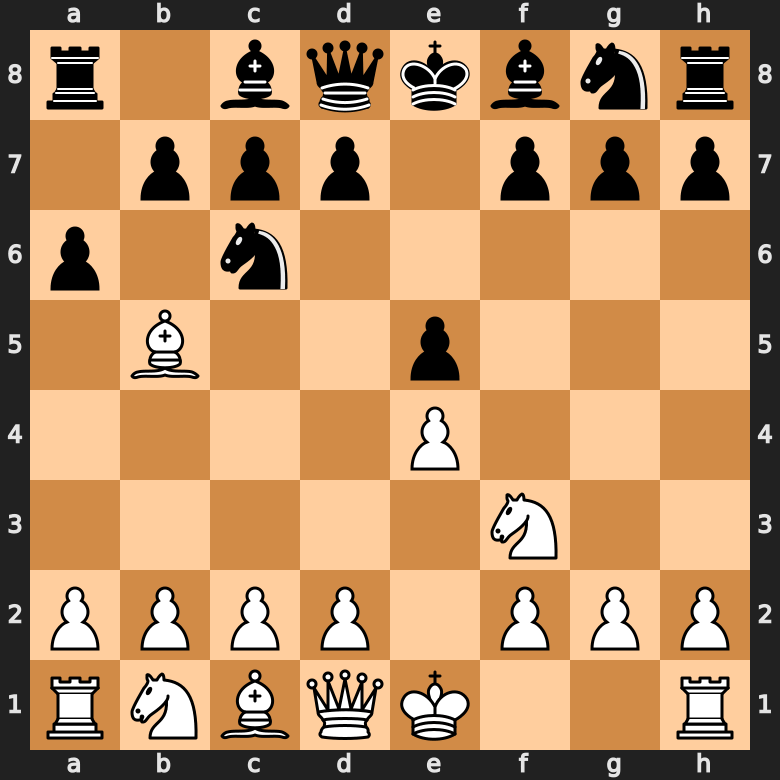
In this case White attacks the black knight on c6, which is defended by both of Blacks pawns. White decides to capture the knight, and Black recaptures the bishop with his own pawn. Since knight and bishop are roughly equal in terms of value, this would be considered a fair exchange.
Exceptions: Castling, Pawn Promotion and En Passant
There are a few exceptions to the regular moves in chess: Castling, Pawn Promotion, and capturing “En Passant“. We have specific guides for each of them, in case you want to learn more.
Castling
Castling is a move that is intended to develop the rook into the game, while simultaneously protecting your king. Castling involves two steps 👣:
- The king moves two squares towards either rook.
- The rook “jumps over” the king and is placed directly to his side.
Since the chess board is not symmetric, there is a short (or king-side) castle (with the rook closer to the king) and a long (or queen-side) castle (with the rook closer to the queen). The procedure remains the same; just the end position is different.
Here you can see a king-side / short castle in action:

However, there are certain restrictions when it comes to castling. Generally, four requirements have to be met to be allowed to castle your king and rook:
- The king and rook have not moved yet in the game.
- The king is not in check at the time of castling.
- The king doesn’t have to castle through attacked squares.
- The squares between the king and rook are unoccupied.
Pawn Promotion
Another special move in chess is the so-called “pawn promotion“. Whenever a pawn reaches the other side of the board, it is immediately turned into either a new queen, rook, bishop, or knight. While the piece it turns into can be chosen freely, the promotion itself is mandatory. It is not possible for the pawn to stay a pawn on the back rank.
This is how a pawn promotion looks in game:
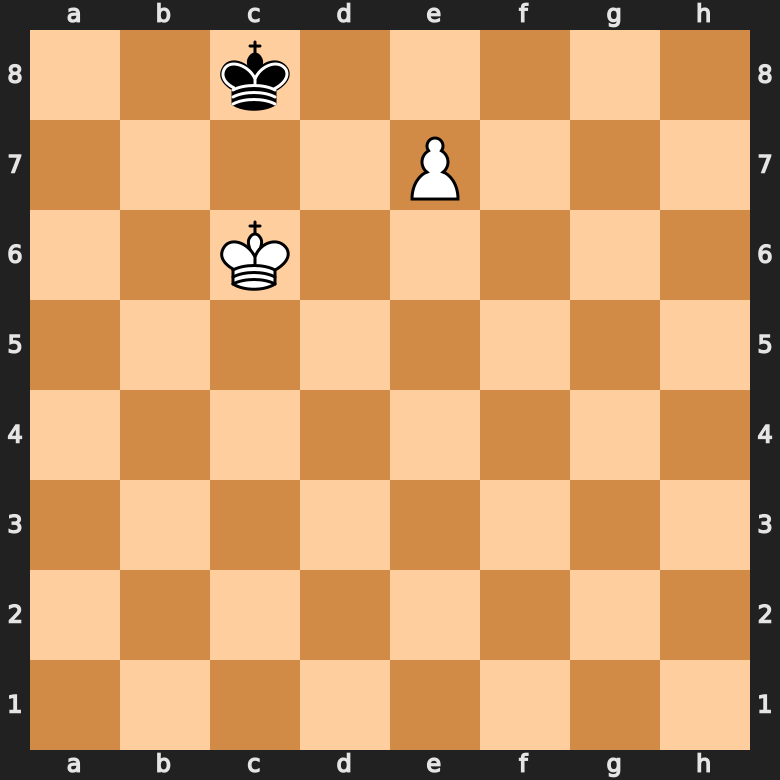
It is also possible to promote a pawn while capturing an enemy piece on the back rank. There is no limit on how many pieces you can promote to – as long as you have pawns, you can promote them. Theoretically, it is possible for a player to have as many as nine queens on the board 😳.
En Passant
The last move we’ll have a look at is capturing “en passant“. En passant is French for “in passing“. As the name suggests, capturing en passant allows a pawn to capture another pawn that just moved alongside it.
If an enemy pawn moves two squares forward an is horizontally adjacent to our pawn, we are allowed to capture the pawn as if it had only moved one square forward. Sounds complicated? Have a look at en passant in action to grasp the concept:
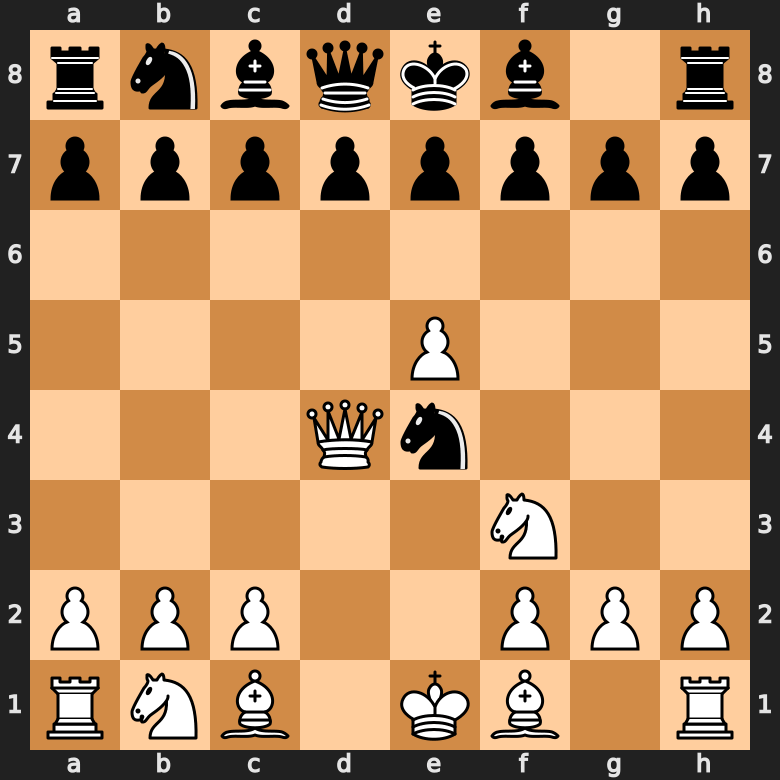
Three rules need to be met for capturing a pawn en passant:
- Both pawns must occupy the same rank (i. e. stand in line horizontally)
- Both pawns must occupy adjacent files (i. e. stand directly besides each other)
- The enemy pawn moved two squares on the previous move
The right to capture en passant must be exercised immediately, or it is lost for the next turn ⛔️.
Check
You probably know by now that the king is quite a special piece. Whenever the king is under attack, he requires your immediate attention. A situation in which the king is under immediate threat of being captured during the opponents next move is called a “check”. A check always has to be defended by getting the king out of the check!
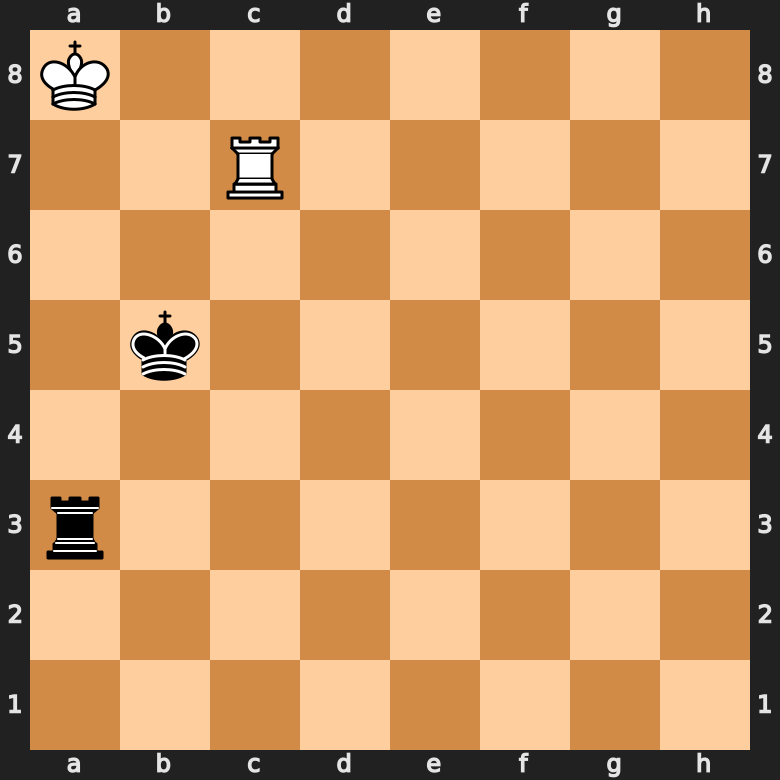
There are three legal ways to respond to a check (i. e. defend a check):
- The king moves out of check
- The attacking piece is captured
- The check is blocked by another piece
All three options lead to the king being out of direct attack for the opponents next move.
Checkmate
Now what happens if you’re not able to defend your king from the check? Well, you just lost the game. Formally, the checkmate is defined as the king being in check and having no legal way to get out of it:

The checkmate is just one way a game of chess can end in a win for one player. Other ways are:
- resignation: A player can concede the game to the opponent by resigning.
- win on time: In time controlled games running out of time will lose the game, if the opponent still has a theoretical possibility to checkmate.
- forfeit: Violating the rules of chess or code of conduct for a given tournament can lead to a player being forfeited.
Stalemate
One way a game of chess can end in a draw is the stalemate. A stalemate is defined as a position in which the king is not checked, but the player has no legal moves.

Other ways the game could end in a draw are:
- dead position: If both players don’t have a theoretical possibility of checkmating the other player by any (legal) squence of moves, the game is declared a draw.
- draw by agreement: If both players agree to a draw, the game is also declared drawn. Usually players can mutually agree to a draw even before the game starts; however, some tournaments require a minimum number of moves before a draw offer can be made.
- threefold repetition: If the exact same position is repeated three times on the board, both players can claim a draw. If the position is repeated five times, the arbiter will intervene immediately and declare the game drawn.
- fifty-move rule: Either player can claim a draw if during the previous fifty moves no pawn has been moved or piece captured. After 75 moves, the arbiter will declare the game drawn.
- draw on time: If a player runs out of time but his opponent has no theoretical possibility of checkmating, the game is also declared a draw.
Learn Basic Chess Strategy
Now that we’re done with learning the basics of chess rules, we can do a short digression into basic chess strategy. Essentially, every game of chess is divided into three phases: the opening, middlegame, and endgame.
Opening
The opening is the first phase of a chess game, which lasts roughly 10 moves. There are an unimaginable amount of possible positions, even after just a few moves. So remembering every possible chess opening is simply not possible. However, most common chess openings are well-studied
In addition, you can navigate unknown openings by adhering to some basic principles. In the opening your main goals should be:
- Developing your pieces
- Occupying or attacking the center squares
- Securing your king by castling
We have a full guide on chess openings on our website.
Middlegame
The middlegame is the phase in which both players have mostly completed their development and the king is (hopefully) securely placed behind a wall of pawns. Because positions in the middlegame are unique from game to game, there is a lot less studied theory on the middlegame compared to openings or endgames.
There are however, certain guidelines you can follow, to improve your chances of getting into the endgame with a favorable position:
- Try to gradually improve the placement of each piece
- Place your rooks on open files
- Avoid or trade-off weak pawns
- Try to trade off material if you have a material advantage
We have a full guide on the chess middlegame on our site.
Endgame
The last phase of a chess game is called the endgame. There is no distinct line where the middlegame transitions into the endgame. However, the end game is characterized by most of the pieces already having been traded off the board.
Remember the following rules and tips to have a successful endgame:
- Learn how to checkmate your opponent by remembering basic checkmating patterns
- Advance your passed pawns
- Attack your opponents weak pawns
- Play slowly and calculate, if you can
We have a full guide on the endgame in chess on our site.
Learning Chess: Where to Go From Here
Now you should be well on your way to becoming a chess pro (okay, maybe you’ll need to practice a bit more)! Here are some further resources you can check out to deepen your knowledge on the chess basics:
Frequently Asked Questions About Learning Chess
- Is Chess Hard To Learn?No! Chess is a perfect example of a game that is easy-to-learn but hard-to-master. You can pick up the chess basics in just a few minutes, but you will probably take years of consistent training to reach your natural limit in chess.
- How Can I Improve in Chess Quickly?Unfortunately, there is no shortcut to improving your chess. Regular training, analysis of your games and a lot of patience are the key to becoming better at chess.
- Is Learning Chess Good For the Brain?Absolutely! There are numerous studies that show the beneficial effects of learning chess on mental capabilities. Chess can definitely help you stay sharp mentally.
Common Beginner Questions in Chess
In this section we have gathered an exhaustive list of question that we often get from chess-beginners. Feel free to browse through!
- Can a King Take a Queen in Chess?
- How Much is Each Chess Piece Worth?
- How Does The Queen Move in Chess?
- How Does The King Move in Chess?
- Can You Have More Than One Queen In Chess?
- How Does The Bishop Move In Chess?
- How Does The Knight Move In Chess?
- How Does The Pawn Move In Chess?
- How Does The Rook Move In Chess?
- Can a Pawn Move Backwards in Chess?
- Which Chess Piece Moves Diagonally?
- Is a Queen Better Than a Rook and Bishop?
- Can a Pawn Take a King in Chess?
- Can The Queen Move Like a Knight in Chess?
- Bishop or Knight: Which is Better?
You can also find the full list here: Common Beginner Questions.

